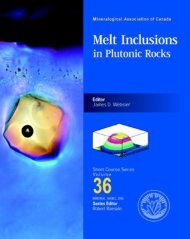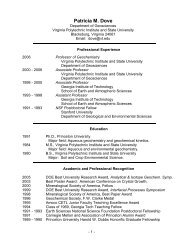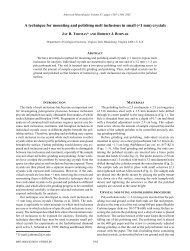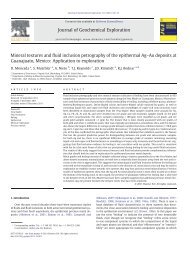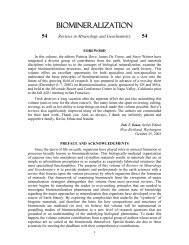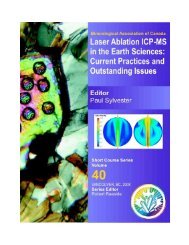Biomineralization Within Vesicles: The Calcite of Coccoliths
Biomineralization Within Vesicles: The Calcite of Coccoliths
Biomineralization Within Vesicles: The Calcite of Coccoliths
Create successful ePaper yourself
Turn your PDF publications into a flip-book with our unique Google optimized e-Paper software.
<strong>Biomineralization</strong> <strong>Within</strong> <strong>Vesicles</strong> 209least since this appears to be a rather flexible biomineralization mechanism capable <strong>of</strong>construction <strong>of</strong> elaborate structures from simple biomineral components. <strong>The</strong>refore, itmay prove a more useful model system than heterococcolith biomineralization forpotential applications in nan<strong>of</strong>abrication.THE EVOLUTION OF COCCOLITHOPHOREBIOMINERALIZATION MECHANISMSAs explained earlier, the haplo-diploid life cycles with holococcolith-heterococcolithalternation are common in coccolithophores and indeed occur in at least six <strong>of</strong> the 13described families. <strong>The</strong>se families span the phylogenetic diversity <strong>of</strong> coccolithophorids,as inferred from both the fossil record and molecular genetics (Young et al. 1999;Houdan et al. in press). Hence, it seems that holococcolith-heterococcolith differentiationmust be a primitive evolutionary feature, with an origin near in time to that <strong>of</strong>calcification in coccolithophores as a whole. This is also supported by the fact that fossilholococcoliths, although much rarer than fossil heterococcoliths, have a record whichextends back nearly as far through geological time. Definite holococcoliths are knownback to the Early Jurassic ca. 190 Ma while definite heterococcoliths occur back to LateTriassic, ca. 220 Ma (Bown 1993, 1998a,b). Given that both heterococcoliths andholococcoliths are elaborate biomineral structures with numerous unique features, theymust each have evolved only once. Hence, it is likely that biomineralization evolved firstin one life cycle phase, then transferred to the other, although, for some reason, only part<strong>of</strong> the process could be transferred.<strong>The</strong> occurrence <strong>of</strong> the heterococcoliths in the fossil record before that <strong>of</strong>holococcoliths provides weak evidence that they evolved first. This might be dismissedas a preservational artifact but it is supported by two other lines <strong>of</strong> evidence. First, all <strong>of</strong>the published molecular genetic analyses (Edvardsen et al. 2000; Fujiwara et al. 2001,Saez et al. in press) find the basal coccolithophore clade is comprised <strong>of</strong> the generaEmiliania and Gephyrocapsa (Family Noelaerhabdaceae). <strong>The</strong>se genera only calcify inthe diploid phase, so their basal position in the tree suggests that the absence <strong>of</strong>calcification in the haploid phase may be a primitive character. This cannot be taken asdefinite evidence however, since calcification is also absent in the haploid phase <strong>of</strong>Pleurochrysis and Hymenomonas, but these have a much higher position within thecoccolithophore clade and therefore must have lost holococcolith biomineralizationsecondarily. Second, two coccolithophore life cycles are now known in which aheterococcolith phase alternates with a nannolith-producing phase (Fig. 11), i.e., a phasethat produces calcareous structures which do not show the characteristic features <strong>of</strong> eitherholococcoliths or heterococcoliths (Young et al. 1999). <strong>The</strong>se examples are (1)Ceratolithus, in which a heterococcolith-producing phase alternates with a phaseproducing large horseshoe-shaped nannoliths (Alcober and Jordan 1997; Young et al.1998; Cros et al. 2000; Sprengel and Young 2000). (2) Alisphaera, in which aheterococcolith-producing phase (Fig. 11E) alternates with a phase producing minute,cup-shaped, aragonitic nannoliths (Fig. 11D−F), as evidenced by the occurrence <strong>of</strong>spectacular combination coccospheres (Cros and Fortuño 2002). <strong>The</strong>se nannoliths,formerly regarded as a discrete genus, “Polycrater”, show some similarities to normalheterococcoliths but are unique in being formed <strong>of</strong> aragonite (Manton and Oates 1980)rather than calcite. <strong>The</strong>y also lack the typical rim features <strong>of</strong> heterococcoliths;consequently Young et al. (1999) highlighted their anomalous structure and consideredthem likely candidates for additional biomineralization modes within thecoccolithophores. This prediction is strongly supported by the combination coccosphereevidence. Neither Ceratolithus nor Alisphaera have yet been isolated into culture so there



